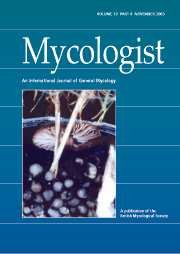Crossref Citations
This article has been cited by the following publications. This list is generated based on data provided by
Crossref.
SCHENA, LEONARDO
HUGHES, KELVIN J. D.
and
COOKE, DAVID E. L.
2006.
Detection and quantification of Phytophthora ramorum, P. kernoviae, P. citricola and P. quercina in symptomatic leaves by multiplex real‐time PCR.
Molecular Plant Pathology,
Vol. 7,
Issue. 5,
p.
365.
Saavedra, A.
Hansen, E. M.
and
Goheen, D. J.
2007.
Phytophthora cambivora in Oregon and its pathogenicity to Chrysolepis chrysophylla.
Forest Pathology,
Vol. 37,
Issue. 6,
p.
409.
Schena, L.
Duncan, J. M.
and
Cooke, D. E. L.
2008.
Development and application of a PCR‐based ‘molecular tool box’ for the identification of Phytophthora species damaging forests and natural ecosystems.
Plant Pathology,
Vol. 57,
Issue. 1,
p.
64.
Jung, Thomas
and
Nechwatal, Jan
2008.
Phytophthora gallica sp. nov., a new species from rhizosphere soil of declining oak and reed stands in France and Germany.
Mycological Research,
Vol. 112,
Issue. 10,
p.
1195.
Balci, Y.
Balci, S.
MacDonald, W. L.
and
Gottschalk, K. W.
2008.
Relative susceptibility of oaks to seven species of Phytophthora isolated from oak forest soils.
Forest Pathology,
Vol. 38,
Issue. 6,
p.
394.
Weiland, Jerry E.
Nelson, Angela H.
and
Hudler, George W.
2009.
Effects of Mefenoxam, Phosphonate, and Paclobutrazol on In Vitro Characteristics ofPhytophthora cactorumandP. citricolaand on Canker Size of European Beech.
Plant Disease,
Vol. 93,
Issue. 7,
p.
741.
Fleischmann, Frank
Winkler, J. Barbro
and
Oßwald, Wolfgang
2009.
Effects of ozone and Phytophthora citricola on non-structural carbohydrates of European beech (Fagus sylvatica) saplings.
Plant and Soil,
Vol. 323,
Issue. 1-2,
p.
75.
Jung, T.
2009.
Beech decline in Central Europe driven by the interaction between Phytophthora infections and climatic extremes.
Forest Pathology,
Vol. 39,
Issue. 2,
p.
73.
Wielgoss, Anna
Nechwatal, Jan
Bogs, Carolin
and
Mendgen, Kurt
2009.
Host plant development, water level and water parameters shape Phragmites australis-associated oomycete communities and determine reed pathogen dynamics in a large lake.
FEMS Microbiology Ecology,
Vol. 69,
Issue. 2,
p.
255.
Winkler, J. Barbro
Fleischmann, Frank
Gayler, Sebastian
Scherb, Hagen
Matyssek, Rainer
and
Grams, Thorsten E. E.
2009.
Do chronic aboveground O3 exposure and belowground pathogen stress affect growth and belowground biomass partitioning of juvenile beech trees (Fagus sylvatica L.)?.
Plant and Soil,
Vol. 323,
Issue. 1-2,
p.
31.
Cerny, K.
Strnadova, V.
Gregorova, B.
Holub, V.
Tomsovsky, M.
Mrazkova, M.
and
Gabrielova, S.
2009.
Phytophthora cactorum causing bleeding canker of common beech, horse chestnut, and white poplar in the Czech Republic.
Plant Pathology,
Vol. 58,
Issue. 2,
p.
394.
Vannini, A.
Natili, G.
Anselmi, N.
Montaghi, A.
and
Vettraino, A. M.
2010.
Distribution and gradient analysis of Ink disease in chestnut forests.
Forest Pathology,
Vol. 40,
Issue. 2,
p.
73.
Rea, Alexander J.
Jung, Thomas
Burgess, Treena I.
Stukely, Michael J. C.
and
Hardy, Giles E. St J.
2010.
Phytophthora elongatasp. nov., a novel pathogen from theEucalyptus marginataforest of Western Australia.
Australasian Plant Pathology,
Vol. 39,
Issue. 6,
p.
477.
Weiland, Jerry E.
Nelson, Angela H.
and
Hudler, George W.
2010.
Aggressiveness of Phytophthora cactorum, P. citricola I, and P. plurivora from European Beech.
Plant Disease,
Vol. 94,
Issue. 8,
p.
1009.
Holub, V.
Černý, K.
Strnadová, V.
Mrázková, M.
Gregorová, B.
and
Gabrielová, Š.
2010.
The survey of some factors affecting bark lesion development caused by Phytophthora cactorum on common beech and other broadleaved trees.
Journal of Forest Science,
Vol. 56,
Issue. 3,
p.
93.
Orlikowski, L. B.
Ptaszek, M.
Rodziewicz, A.
Nechwatal, J.
Thinggaard, K.
and
Jung, T.
2011.
Phytophthora root and collar rot of mature Fraxinus excelsior in forest stands in Poland and Denmark.
Forest Pathology,
Vol. 41,
Issue. 6,
p.
510.
Hong, Chuanxue
Gallegly, Mannon E.
Richardson, Patricia A.
and
Kong, Ping
2011.
Phytophthora piniLeonian resurrected to distinct species status.
Mycologia,
Vol. 103,
Issue. 2,
p.
351.
Vettraino, Anna Maria
Brasier, Clive M.
Brown, Anna V.
and
Vannini, Andrea
2011.
Phytophthora himalsilva sp. nov. an unusually phenotypically variable species from a remote forest in Nepal.
Fungal Biology,
Vol. 115,
Issue. 3,
p.
275.
Nechwatal, J.
Hahn, J.
Schönborn, A.
and
Schmitz, G.
2011.
A twig blight of understorey European beech (Fagus sylvatica) caused by soilborne Phytophthora spp..
Forest Pathology,
Vol. 41,
Issue. 6,
p.
493.
Orlikowski, Leszek
Ptaszek, Magdalena
Trzewik, Aleksandra
and
Orlikowska, Teresa
2011.
First Report of Phytophthora Inflata in Polish Rhododendron Nursery.
Journal of Plant Protection Research,
Vol. 51,
Issue. 1,
p.
50.




